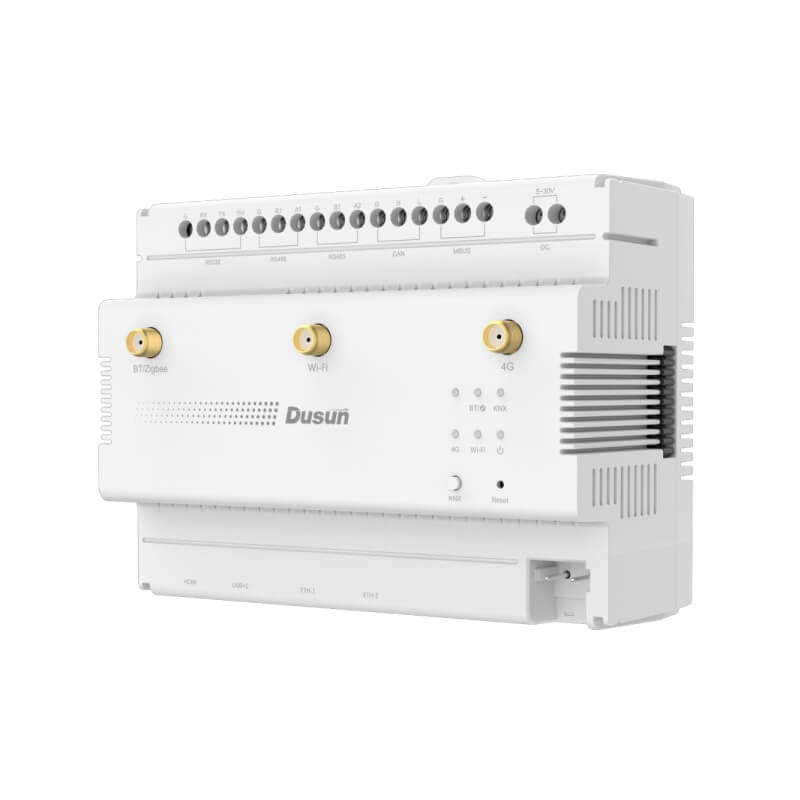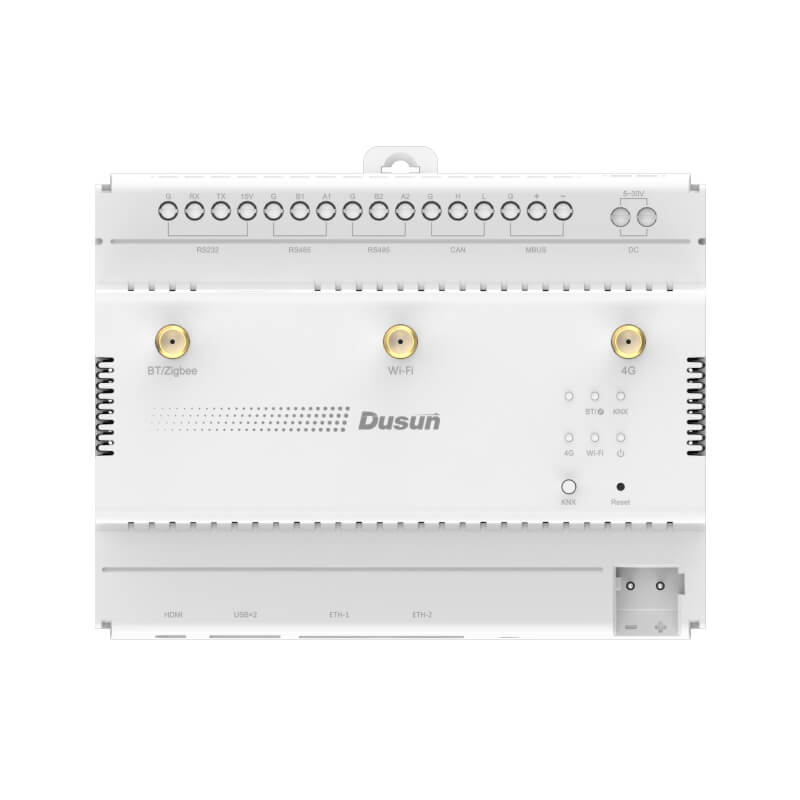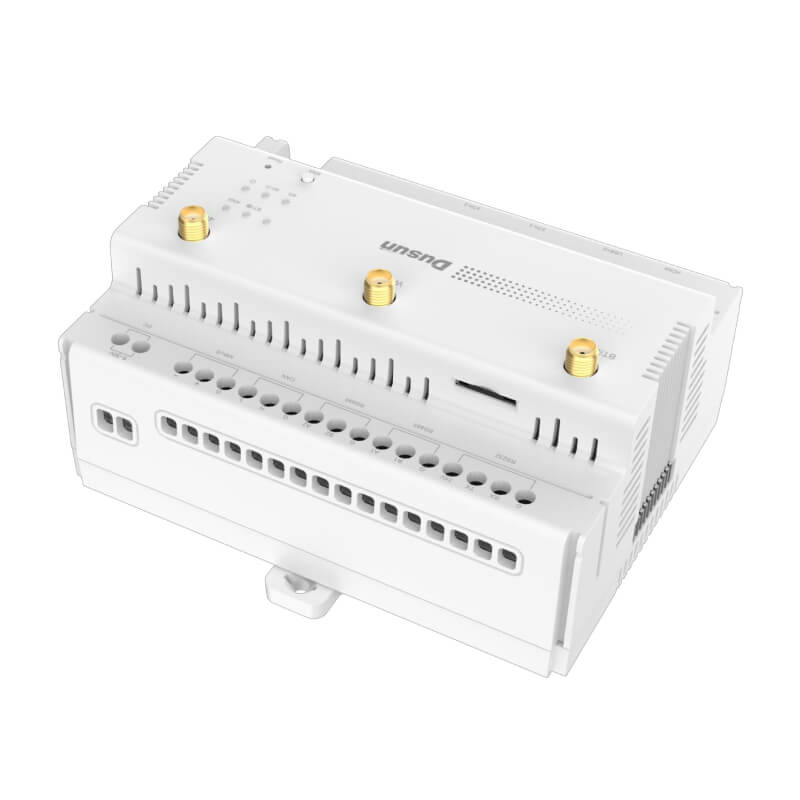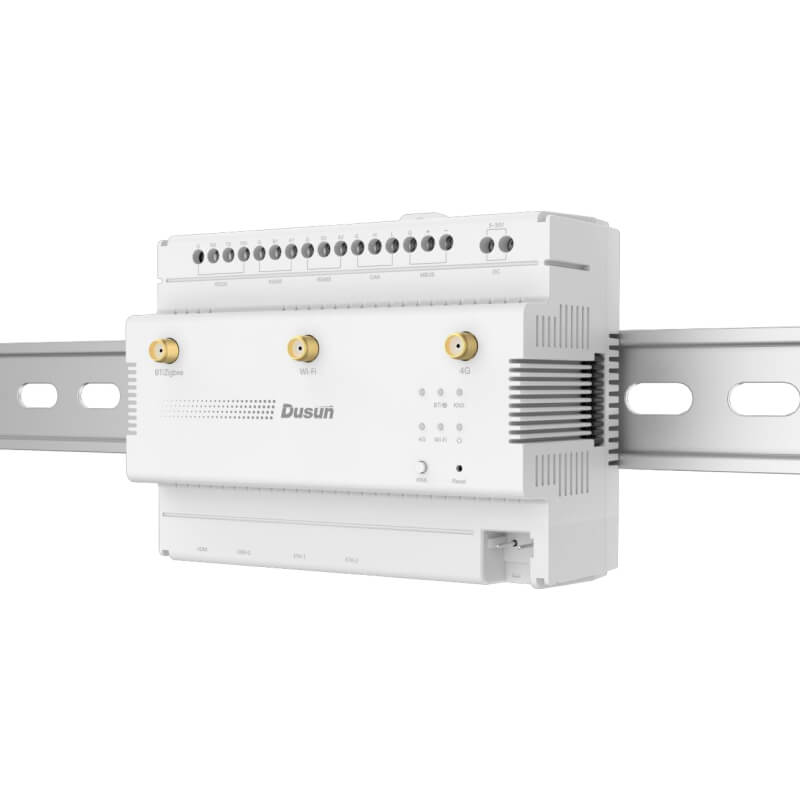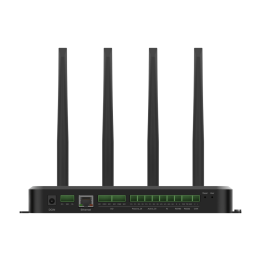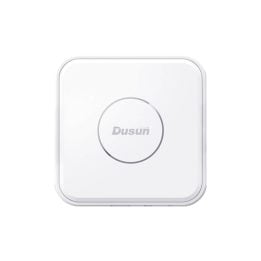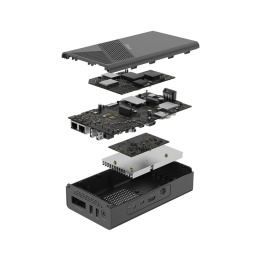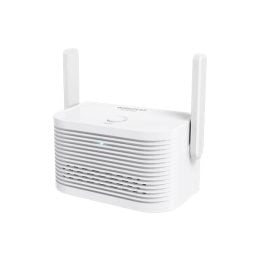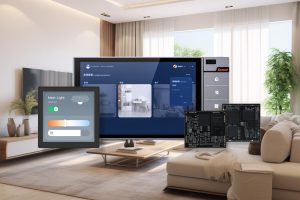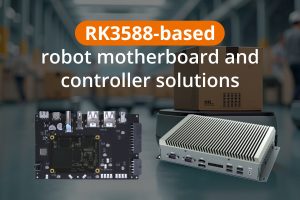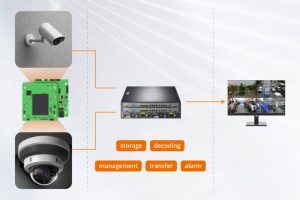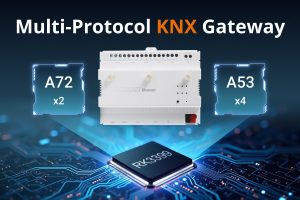Overview of DSGW-510 KNX Zigbee IoT Gateway
KNX is a standard for building automation that allows various devices and systems within a building (like lighting, heating, security systems, etc.) to communicate with each other. DSGW-510 KNX IoT Gateway is the ultimate integration hub designed for modern automation environments. It can act as a protocol conversion gateway based on KNX Bus communication, and enables data exchange with devices of different protocols, including Zigbee, Bluetooth, M bus etc., enabling these devices to be controlled or monitored remotely or integrated with other systems to provide advanced functionality like automation and remote management for smart home application & building automation.
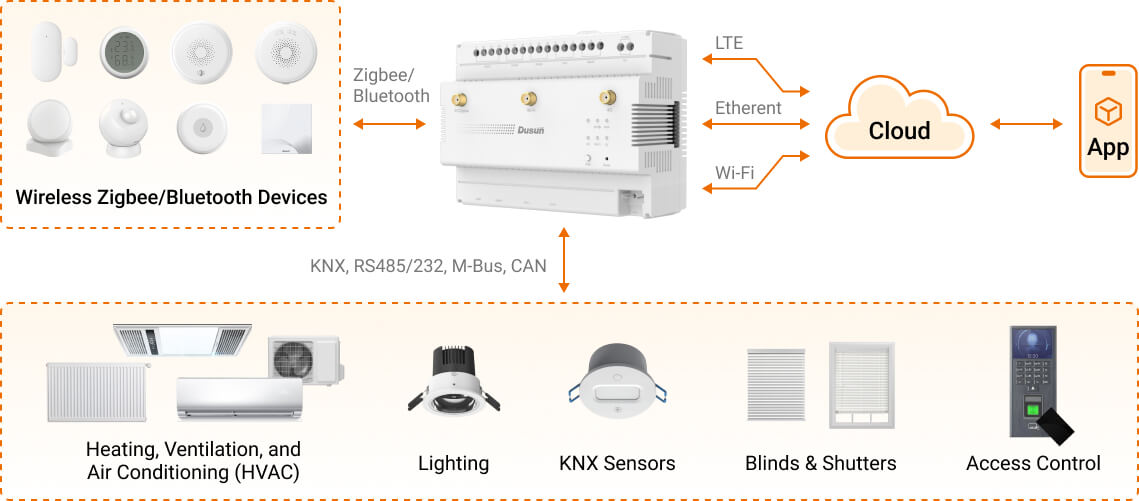
Features of DSGW-510 KNX Zigbee IoT Gateway
KNX standard datapoints (DPTs) support
KNX standard datapoints (DPTs) are supported, guaranteeing a simple KNX device/system integration.
Multi-Protocol Support
Supporting KNX, Zigbee, Wi-Fi, LTE, and more, the KNX Zigbee gateway connects diverse devices, creating a unified and streamlined network for various automation needs.
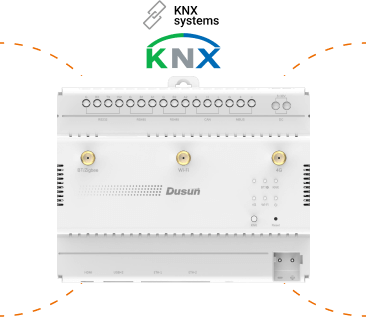
Embedded M-Bus level converter
An M-Bus level converter is embedded in the gateway, so no external one is required.
Programmable with Development Resources & Support
Easily port or independently develop KNX system, or modify and conduct secondary development on the underlying firmware based on the open-source SDK
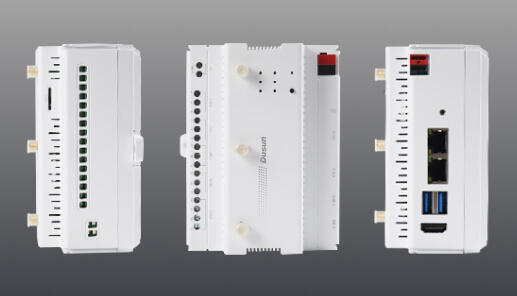
Rich Interface Options
Equipped with Ethernet, RS485, RS232, M-Bus, CAN and USB 3.0 interfaces, the DSGW-510 KNX IoT Gateway provides versatile connectivity to both legacy and modern devices across applications.
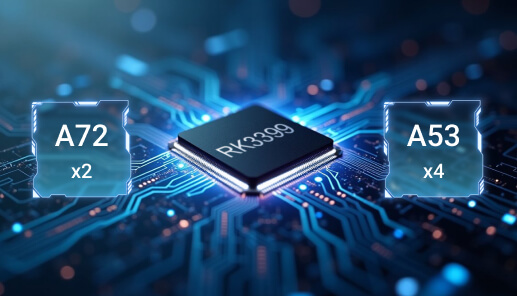
High-Performance CPU
The DSGW-510 KNX Zigbee gateway features a powerful dual-core ARM Cortex-A72 and a quad-core ARM Cortex-A53, ensuring rapid processing and efficient handling of complex tasks.
Rail Installation & Expansion Module Support
Offer easy and efficient mounting on standard DIN rails while allowing for seamless integration of additional modules to expand wireless modules (Bluetooth, ZigBee, ZWAVE, etc) and rich I/O interfaces (RS485/RS232, switching input DI, switching output DO, analog input AI, analog output AO, thermal resistor PT100/PT1000/NTC, digital DI/DO, etc) capabilities and adapt to evolving KNX system needs.

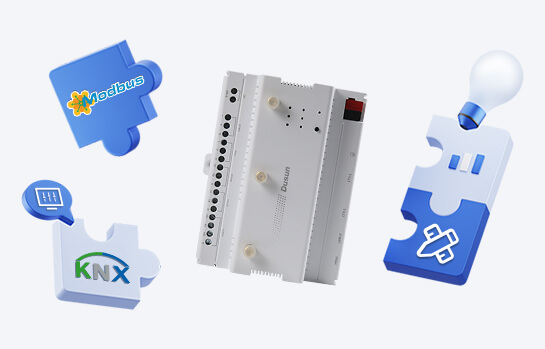
Scalability and Customization
Scales with network growth, supporting more devices and protocols like KNX to Modbus, with customization options available through Dusun’s development services.
Inner Board & Packaging of DSGW-510 KNX Zigbee IoT Gateway
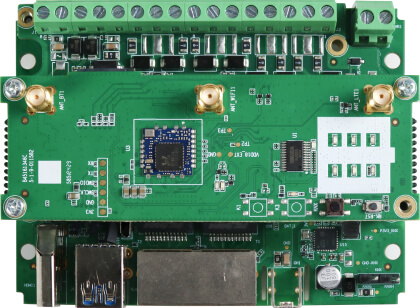
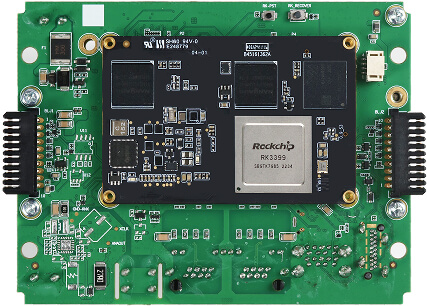
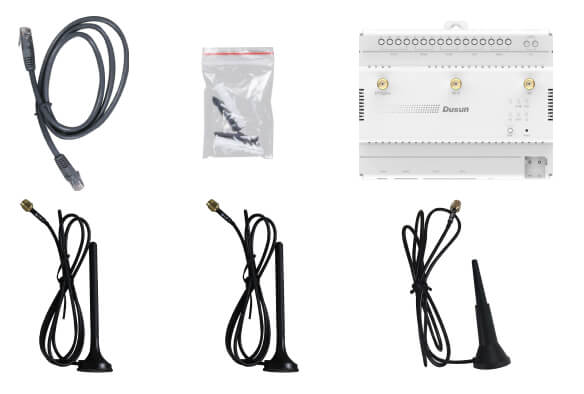
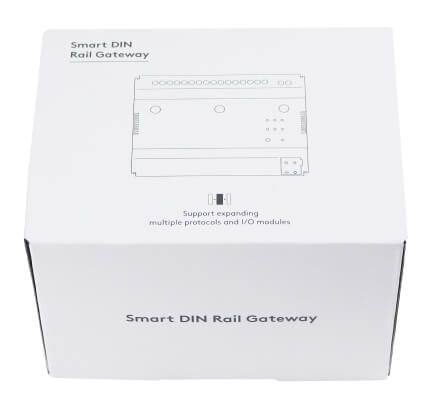
Parameters of DSGW-510 KNX Zigbee IoT Gateway
| Category | Specifications |
|---|---|
| CPU | RK3399 Dual-core ARM Cortex-A72 Core processor and Quad-core ARM Cortex-A53 Core processor |
| System | Debian12, Ubuntu18.04, Android10.0, Buildroot+QT |
| RAM | 4GB DDR3 |
| Flash | 32GB eMMC |
| Power | ● DC 12V input ● Wide crimping capability for 5-30V input |
| Ethernet | 2 * 100/ 1000Mbps |
| USB | 2 * USB 3.0 |
| Debug | PCB support |
| Wireless protocol | ● WiFi 2.4G/5G ● Lte Cat1/Cat4 ● Wireless (optional): Choose one from Bluetooth, ZIGBEE or Z- WAVE |
| Antenna | ● WIFI x 1 ● 4G x 1 ● Wireless (optional) x 1 |
| KNX | Support |
| LED | ● Power LED: Always on when powered on, off when powered off ● WIFI LED: Always on when the module is in place, flashing when the terminal is connected, and off when the module is not in place ● Wireless(optional) LED: Always on when the module is in place, flashing when the terminal is connected, and off when the module is not in place - optional for ZigBee, Z-Wave, and Bluetooth ● LTE Signal LED: Always on when the module is in place, flashing when connected to the network, and off when the module is not in place ● KNX LED: The KNX terminal stays on when connected and turns off when disconnected ● Ethernet LED: Always on after Uplink and off after Down (yellow) |
| Interface | ● RS485 x 2 (Phoenix terminal) ● RS232 x 1(Phoenix terminal) ● M-Bus (3UL Max) x 1(Phoenix terminal) ● CAN x 1(Phoenix terminal) ● HDMI x 1 |
| SIM Slot | SIM Card Slot x 1 |
| Expansion Module | The left side of the product can be expanded with wireless modules (Bluetooth, ZigBee, ZWAVE), and the right side can be expanded with IO interface modules |
| Reset | Short press to restart the device, long press for 5 seconds to restore factory settings |
| Storage Temperature | -40℃~85℃ |
| Operating Temperature | 0~55℃ |
| Ambient Humidity | 10~90% |
| IP rating | IP30 |
| Cooling | Heat dissipation, silicone/ aluminum |
| Size | 118 * 90 * 58mm |
Applications of DSGW-510 KNX IoT Gateway
Specifically designed for a wide range of applications, the DSGW-510 KNX IoT gateway excels in scenarios, including:

Automating lighting, HVAC, and security systems to enhance comfort and energy efficiency.
Enable seamless integration and intelligent control of various building systems for enhanced efficiency, security, and comfort in building automation.

Facilitate intelligent EV charging by integrating charging stations into a unified building energy management system, optimizing energy use and enhancing control.
Dusun KNX IoT Gateway Secondary Development Support
Dusun IoT provides comprehensive, rigorously tested development resources, ensuring high reliability and efficiency. Our expert FAE team offers personalized one-on-one support for partners addressing technical challenges during IoT gateway secondary development, accelerating time-to-market and gaining a competitive edge.
Smart Terminal Connectivity Support
- Mastery of mainstream wired and wireless IoT protocols for quick smart terminal connections and debugging
- Standard object model design and Luci local management tool for visual and rapid development
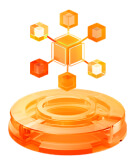
System/Application Porting
- Support Docker for application porting to expedite existing software/tools migration and debugging, cutting development costs and time
- Embedded algorithm model tools for easy local algorithm compilation and porting
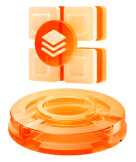
Software Development & Deployment Support
- Open-source SDKs for deeper customization, allowing custom firmware to fit specific hardware or functional optimization
- Open APIs for developing software functionalities like data collection and device control
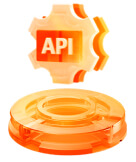
Cloud Platform Integration
- Support for standard MQTT/HTTP protocols (e.g., BLE2MQTT, Beacon2MQTT) for seamless third-party cloud integrations
- Pre-installed AWS and Azure plugins for zero-code integration with mainstream cloud platforms

FAQs of KNX IoT Gateway
What is the KNX protocol?
The KNX protocol is a standardized (ISO/IEC 14543-3) communication protocol used for building automation, enabling various devices and systems such as lighting, HVAC, and security systems to communicate and work together seamlessly.
What is a KNX gateway?
A KNX gateway is a device that facilitates communication between KNX networks and other protocols or systems, enabling integration and interoperability in building automation applications.
What is the difference between Zigbee and KNX?
Zigbee is primarily a wireless communication protocol used in home automation to connect smart devices, while KNX is a wired and wireless protocol widely used for building automation, offering more robust integration and support for a wide range of building systems.
What protocols does the DSGW-510 KNX IoT gateway support?
The DSGW-510 KNX IoT Gateway supports multiple communication protocols, including KNX, Zigbee, Wi-Fi, Ethernet, RS485, RS232, M-Bus, CAN, and Bluetooth, providing comprehensive integration across different systems.
Can the DSGW-510 KNX Zigbee gateway be used in industrial settings?
While the DSGW-510 KNX IoT Gateway is suitable for many indoor industrial environments with controlled temperatures, its operating range (0~55℃) may limit use in extreme conditions.
What are the installation requirements for the DSGW-510 KNX IoT Gateway?
The DSGW-510 KNX IoT Gateway features a compact rail-mount design for easy installation on standard DIN rails, ensuring simple integration into existing automation systems, whether in residential or controlled industrial locations.
What are KNX devices?
KNX devices are components such as sensors, gateways, actuators, and controllers that use the KNX protocol to automate and control various functions in a building, facilitating integrated management across systems like lighting, heating, and access control.









